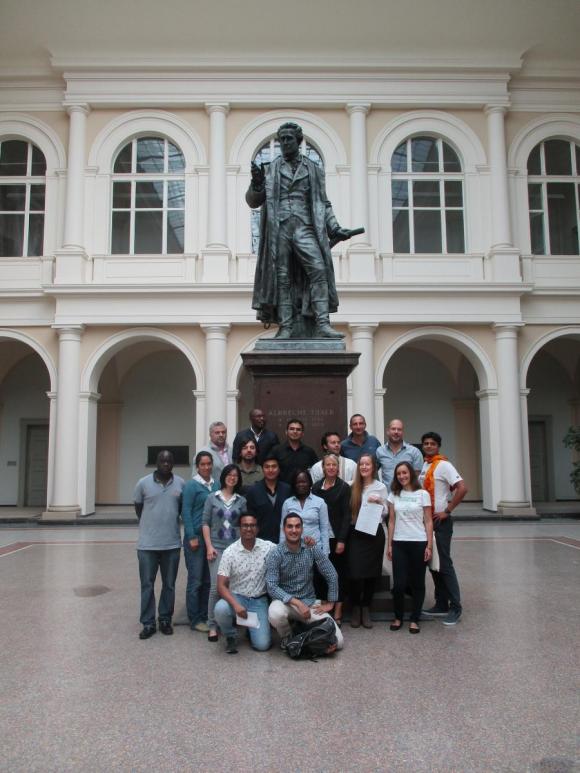-
About
- Our Work
- Get Involved
- Stay Updated
Social Media from Ypard to AgTraIn: Communicating for agricultural development
Photo Credit: Sanjeeb Bhattarai
On September 15th, AgTraIn Doctoral candidates attended a Social Media Lecture by Marina Cherbonnier from Ypard in the Humboldt University of Berlin. The lecture was part of the course “Applied research communication and disseminating for agricultural development” organized by the University of Copenhagen, with the collaboration of the other five AgTraIn Universities: Wageningen University; Montpellier Supagro; University College of Cork, Universita Degli Study di Catania; and Politécnica de Madrid.
Yes, Ypard and AgTraIn rock!
Why Social Media in a Scientific Communication Course of a PhD programme?
Web 2.0 and its social platforms have gained ground on traditional media. In August 2015, Facebook reached the one billion users. In other words, one out of seven people in the world used it. Such a powerful tool brings and spreads the news before any other traditional channel. People inform and get informed by tweets or blog posts; they promote themselves through LinkedIn profiles; or they share pictures in Flickr. Besides, mobile devices such as smartphones, laptops or tablets generate and bring information from anywhere in the world.
In our struggle as PhD students to bring our work and science to a broader audience, social media can definitely play a major role. And whats even more interesting,it’s for free!
So what did we learn?
Key striking things
We took a tour to discover or re-discover the social media websphere:
1. What are the different tools and what are their benefits?
Starting with Twitter, we understood its terminology and rules. A hashtag (#) is a label to write or find content about a specific theme. A Trending Topic (TT) in a region, country or worldwide is a word, phrase or theme that is mentioned at a higher rate in the tweets. As an example we mentioned the Arab Spring, also dubbed as the Twitter Revolution. Imagine that the conference you are attending manages to become Trending Topic, you can get great visibility! And the best part: 140 characters force you to be concise. (Social science guys will be struggling!)We continued with Facebook and its three formats: Pages, groups and users. Nowadays most of the organizations working in our fields have a Facebook Page. Just “liking” them is one of the best ways to stay up to date about their work. Groups are private spaces where you can share information with for instance your colleagues, and of course to join a group you should have an account and become a user.
Marina highlighted LinkedIn for networking and professional promotion. The fact is that LinkedIn has become an important meeting point to create a network and place your CV. Human resources use it to recruit you! Since recently, you can also use a publishing platform in LinkedIn. Do not miss it.
What about blogs? Wordpress and blogger are the most famous platforms. Labels to position your post, the possibility to add pictures and videos (embedded from Youtube) and no space limitation are some of its characteristics. Excellent examples of good blogging are the Ypard and Agtrain Blogs!
We also talked about others platforms such as Instagram, flickr, pinterest, youtube, etc. There are a variety of social networks. And also very relevant for researchers: Research Gate. Its mission is to connect researchers to share and access scientific outputs and knowledge.
2. Having a strategy of communication
Effective communication in social media is usually preceded by a good strategy. Some steps in the creation of a communication stsrategy include:
• Target your communication: It means selecting and understanding your audience.
• Find a good story: Something of interest for your audience.
• Tell a good story: The way you tell it will keep the audience reading it.
• Analyze it and improve it: Adapting your communication to make it better.
Excellent examples of effective communication are Greenpeace campaigns for its strategies of direct action, political lobbying and public education.3. Tweeting and blogging at conferences
There are some rules of thumb about how to write good tweets. Called as “live tweeting”, more and more people are using Twitter during posters and oral presentations at conferences. An article in Plos One describes ten simple rules of live tweeting at scientific conferences. On the other hand if you could not assist to the Conference or missed some of the events, an alternative way to follow it is through social media.As an example have a look in the fantastic work from student reporters during the recently concluded Tropentag 2015 conference in Humboldt University of Berlin.
Lastly,we would like to thank Ypard and Marina for their inspiring lecture. All the best from AgTraIn and see you at Social Media!
Tags:About the author
Related Posts
Comments
No comments made yet. Be the first to submit a commentBy accepting you will be accessing a service provided by a third-party external to https://ypard.net/
Get in touch
Email: [email protected]
YPARD Global Coordination UnitHosted by AGRIDEA and the Czech University of Life Sciences Prague
Lausanne, Switzerland and Prague, Czech Republic - Our Work


